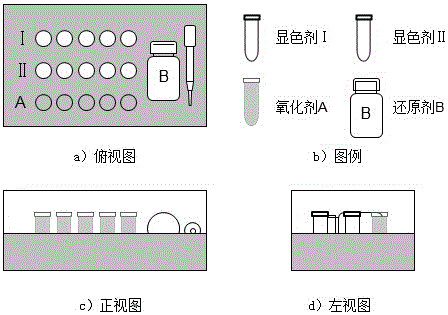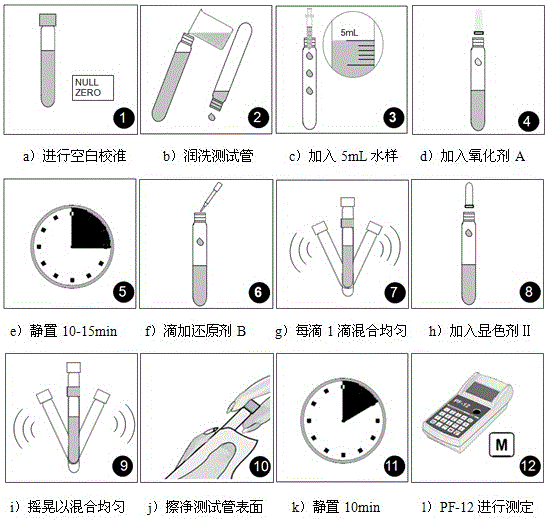On-site emergency detection reagent for chromium in water and use method thereof
An emergency detection and reagent technology, applied in the field of analysis and detection, to achieve the effects of good stability, simple operation and high sensitivity
- Summary
- Abstract
- Description
- Claims
- Application Information
AI Technical Summary
Problems solved by technology
Method used
Image
Examples
Embodiment 1
[0032] Preparation of chromium (VI) detection reagent: weigh 1g of diphenylcarbazide and 20g of sodium chloride, mix and grind evenly to obtain a solid developer; measure 50mL of 85% phosphoric acid and mix with 50mL of deionized water to obtain 1+1 phosphoric acid; Weigh 0.2 g of solid color developer, add 0.1 mL of 1+1 phosphoric acid, 0.5 mL of ethyl acetate, and mix with deionized water to 1 mL to obtain color developer I.
Embodiment 2
[0034] Preparation of total chromium detection reagent: Weigh 0.2g solid color developer, add 0.5mL ethyl acetate, mix with deionized water to 1mL to obtain color developer II; weigh 0.404g ceric sulfate, dissolve in 50mL deionized water , add 10mL of 1+1 phosphoric acid and heat to dissolve, after cooling, take 0.1mL of the solution and deionized water to make 1mL of reagent to obtain oxidant A; weigh 0.2g of sodium azide, dissolve in 100mL of deionized water to obtain reducing agent B.
[0035] The above-mentioned diphenylcarbazide, sodium chloride, ethyl acetate, ceric sulfate, and sodium azide are commercially available analytically pure chemicals.
Embodiment 3
[0037] The chromium (VI) detection reagent obtained in Example 1 of the present invention was used to determine the concentration of chromium (VI) in simulated low-pollution water samples of the Songhua River.
[0038] After the Songhua River water sample was filtered through filter paper, 5 mL was taken in a glass test tube, and 0.1 mL of 10 mg / L chromium (Ⅵ) standard solution was added to the test tube to simulate a low-concentration polluted water sample. Add chromogenic agent Ⅰ (1mL) and add water to 10mL, shake evenly, let stand for 10min, measure the absorbance at a wavelength of 540nm with a spectrophotometer, and calculate the concentration by substituting it into the chromium (Ⅵ) standard curve. The results of the six measurements are respectively : 0.117, 0.117, 0.119, 0.117, 0.118, 0.116mg / L, the relative standard deviation was 0.88%, and the recovery rate was 97.67%. The result determined by the national standard method is 0.120mg / L, and the value difference is sma...
PUM
 Login to View More
Login to View More Abstract
Description
Claims
Application Information
 Login to View More
Login to View More - R&D
- Intellectual Property
- Life Sciences
- Materials
- Tech Scout
- Unparalleled Data Quality
- Higher Quality Content
- 60% Fewer Hallucinations
Browse by: Latest US Patents, China's latest patents, Technical Efficacy Thesaurus, Application Domain, Technology Topic, Popular Technical Reports.
© 2025 PatSnap. All rights reserved.Legal|Privacy policy|Modern Slavery Act Transparency Statement|Sitemap|About US| Contact US: help@patsnap.com



